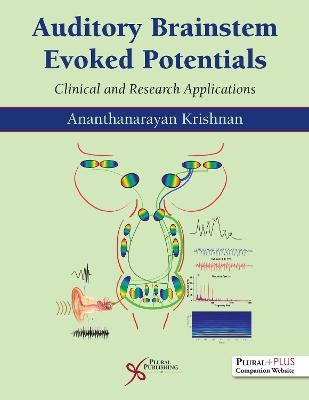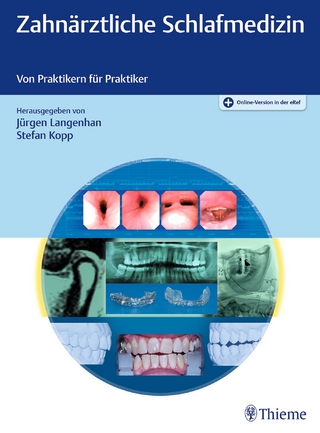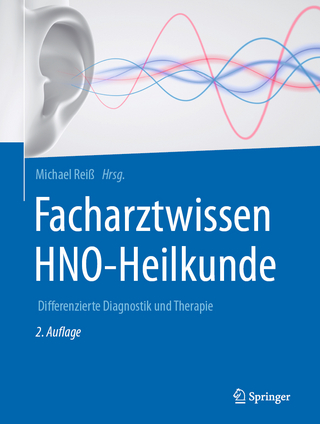
Auditory Brainstem Evoked Responses
Plural Publishing Inc (Verlag)
978-1-63550-239-8 (ISBN)
Auditory Brainstem Evoked Potentials: Clinical and Research Applications provides a solid foundation of the theoretical principles of auditory evoked potential principles essential for understanding the neural bases of changes in the response indices essential for both the development of optimal clinical test strategies, and interpretation of test results. Developed for graduate-level audiology students, this comprehensive text aims to build a fundamental understanding of auditory evoked brainstem responses (ABR), and their relationship to normal and impaired auditory function, as well as its various Audiologic and Neurootologic applications.
In addition to covering the classical onset ABR, the book provides a thorough review of sustained brainstem responses elicited by complex sounds, including auditory steady state response (ASSR), envelope following response (EFR), and frequency following response (FFR), and the growing clinical and research applications of these responses. By exploring why certain stimulus manipulations are required to answer specific clinical questions, the author provide the resources needed for students and clinicians to make reasoned decisions about the optimal protocol to use in a given situation.
Key Features
A full chapter devoted to laboratory exercises
Numerous illustrations to help explain key concepts
Description of neural bases underlying amplitude and latency changes
Troubleshooting techniques
End-of-chapter summaries
A PluralPlus companion website with PowerPoint slides for instructors and case studies for students
Ananthanarayan (Ravi) Krishnan, PhD, CCC-A, is currently a Professor in Audiology/Hearing Science in the Department of Speech, Language, and Hearing Sciences at Purdue University. Prior to his current position, he was an Associate Professor in Audiology/Hearing Science in the Department of Audiology and Speech Sciences at the University of Tennessee. He did his undergraduate work at the All India Institute of Speech and Hearing (University of Mysore), his graduate work in Audiology (Master's) at the University of Memphis, and his doctoral work in Auditory Neuroscience at the University of Texas-Dallas. His research uses brainstem and cortical electrophysiological measures to evaluate neural representation of complex sounds in normal and impaired ears. The focus of his current research is on the processing of pitch-relevant information at the brainstem and cortical levels and how this processing is shaped by experience.
Preface
Reviewers
Chapter 1. Overview of the Neuroanatomy of Auditory Periphery and Brainstem
Scope
I. Auditory Periphery: Cochlear and Auditory Nerve Neuroanatomy
Cochlea: Structure and Functional Implications
Afferent Innervation of the Cochlea
Formation of the Auditory Nerve
II. Neuroanatomy of the Auditory Brainstem
Salient Features of Organization of Brainstem Structures and Pathways
Cochlear Nucleus (CN)
Superior Olivary Complex (SOC)
Nuclei of Lateral Lemniscus (NLL)
Inferior Colliculus (IC)
III. Efferent Pathways
Efferent Innervation of the Cochlea
Efferent Innervation of the IC
IV. Summary
V. Recommended Readings:
Excellent Reviews With Sufficient Detail
References
Chapter 2. Neural Activity Underlying Scalp Recorded Evoked Potentials
Scope
I. Neuronal Physiology
Structure of a Neuron
Requirements for Neural Signaling
Generation and Maintenance of the Resting Membrane Potential (RMP)-Polarized Cell
Action Potential: Generation, Propagation, and Synaptic Transmission
II. Neural Bases of Evoked Potentials
III. Auditory Evoked Potentials (AEP): Classification and Types
IV. Summary
V. Recommended Readings
Excellent Review of Dipoles and Overview of Neuronal Physiology
References
Chapter 3. Stimuli and Data Acquisition Principles
Scope
I. Stimulus Section
Stimulus Type
Transducer Type
Calibration of Stimulus Intensity
How Do These SPL Measures Translate to the dB nHL Scale?
II. Analog Signal Conditioning and Pre-Processing Section
III. Digital Signal Processing Section
IV. Summary
V. Recommended Readings
Excellent Chapters With More Details
References
Chapter 4. Normative Aspects of the Auditory Evoked Responses from the Brainstem
I. Auditory Brainstem Responses (ABR)
ABR Components and Response Morphology
Neural Generators of the ABR Components
Latency Correspondence Between Intracranial and Scalp Recorded ABR Components
Identification of ABR Generators in Individuals with Confirmed Focal Brainstem Lesions
ABR Response Indices
What Are the Physiological Determinants of ABR Response Latency and Amplitude?
Response Amplitude
Effects of Stimulus Factors
Effects of Recording Factors
Effects of Subject Factors
II. Summary
References
Chapter 4. Normative Aspects of the Auditory Evoked Responses from the Brainstem
I. Auditory Brainstem Responses (ABR)
ABR Components and Response Morphology
Neural Generators of the ABR Components
Latency Correspondence Between Intracranial and Scalp Recorded ABR Components
Identification of ABR Generators in Individuals with Confirmed Focal Brainstem Lesions
ABR Response Indices
What Are the Physiological Determinants of ABR Response Latency and Amplitude?
Response Amplitude
Effects of Stimulus Factors
Effects of Recording Factors
Effects of Subject Factors
II. Summary
References
Chapter 5. Clinical Applications of the Auditory Brainstem Responses: Audiologic Applications for Hearing Screening, and Threshold Estimation
Scope
I. Hearing Screening
Hearing Screening: Factors Determining Optimal Implementation
Hearing Screening Protocols
II. Frequency Specific Threshold Estimation Using Auditory Brainstem Responses
Frequency and Place Specificity
Derived Narrow-Band Responses Using High Pass Masking Noise on Click-Evoked ABRs
Notched Noise Masking to Ensure Place Specificity of the ABR
Estimation of the Air-Conduction Threshold Using ABRs Elicited by Frequency Specific Tone Bursts
Estimation of the Bone-Conduction Threshold Using ABRs Elicited by Frequency Specific Tone Bursts
AC-ABR and BC-ABR Protocols for Threshold Estimation
Preliminary Considerations
ABR-AC and ABR-BC Threshold Estimation Procedure
Click ABR Protocol to Identify Auditory Neuropathy
Emergence of Narrow-Band Chirp Stimuli to Estimate AC-ABR and BC-ABR Thresholds
III. Frequency Specific Threshold Estimation Using the Brainstem Auditory Steady-State Response (ASSR)
IV. Summary
References
Chapter 6. Clinical Applications of the Auditory Brainstem Response: Differential Diagnosis
Scope
I. ABR in Conductive Hearing Loss (CHL)
Effects on ABR Characteristics
Effects of Chronic Middle Ear Infection on the Brainstem Response
CHL Causes Structural and Functional Changes in the Auditory Brainstem
II. ABR in Cochlear Hearing Loss
Effects on ABR Characteristics
Relationship Between Magnitude of Latency Shift and Degree and Configuration of Cochlear Hearing Loss
Relationship Between Slope of Wave V Latency-Intensity Function and Degree and Configuration of Cochlear Hearing Loss
Effects of Cochlear Hearing Loss on ABR Interpeak Latencies
III. ABR in Auditory Nerve and Brainstem Lesions
Effects on ABR Response Characteristics
Effects of Auditory Nerve and Lower (Caudal) Brainstem Lesions on the ABR
Abnormal Interpeak Latencies (IPL: I-III, I-V, and III-V)
Abnormal Interaural Latency Difference in Wave V (ILDv)
ABRs Sensitivity Is Reduced in the Detection of Small Auditory Nerve Tumors
Stacked ABR as a Method to Improve Detection of Small Acoustic Tumors
Relationship Between ABR and Auditory Nerve Tumor Size
Bilateral Effects of Auditory Nerve and Lower Brainstem Lesions
Use of V/I Amplitude Ratio in the Detection of Auditory Nerve and Lower Brainstem Lesions
IV. ABR in Auditory Neuropathy and Cochlear Synaptopathy
Introduction
ABRs in Auditory Neuropathy
ABRs in Cochlear Synaptopathy
V. ABR in Upper (Rostral) Brainstem Lesions
ABR Response Characteristics
VI. ABR Test Strategy for Neurodiagnostic Evaluation of Site(s) of Lesion
Choice of Stimulus Parameters
Choice of Recording Parameters
VII. Summary
References
Chapter 7. Neurotologic Applications: Electrocochleography (ECochG) and Intraoperative Monitoring (IOM)
Scope
I. Electrocochleography (ECochG)
Cochlear Microphonic (CM)
Clinical Applications of the CM
Summating Potential (SP)
Clinical Applications of SP
Whole Nerve Compound Action Potential (CAP)
II. ABR Diagnostic Measure for Cochlear Hydrops: Cochlear Hydrops Analysis Masking Procedure (CHAMP)
III. The Electrical Compound Action Potential (eCAP) and Its Application in Cochlear Implants: Intracochlear ECochG
Response Characteristics
Clinical Applications
IV. Electrical ABR (eABR) and Its Application in Cochlear Implant Evaluation
Response Characteristics of the Normal eABR
Methods to Record and Analyze the eABR
V. Application of Auditory Nerve and Brainstem Responses in Intraoperative Monitoring.
Introduction and Rationale
Surgical Approaches
Commonly Used Measures for IOM
IOM Procedures and Interpretation of Changes in Response During Surgery
Stimulus
Response Recording
Response Interpretation and Reporting
Hearing Preservation (HP) in IOM
VI. Summary
References
Chapter 8. Brainstem Evoked Responses to Complex Sounds: Characteristics and Clinical Applications.
Scope
I. Envelope Following Response (EFR)
II. Response Characteristics of EFRs Elicited by SAM Tones
Effects of Intensity
Effects of Carrier Frequency
Effects of Modulation Rate
Effects of Age
III. Use of EFR in Auditory Threshold Estimation
Air-Conduction Threshold Estimation in Adults and Infants with Normal Hearing (AC-EFR)
Threshold Estimation in Adults and Infants with Sensorineural Hearing Loss
Bone-Conduction Threshold Estimation in Normal and Hearing-Impaired Individuals (BC-EFR)
IV. EFRs Elicited by Speech Sounds
Characteristics of Speech Stimuli
Response Characteristics of the EFR to the CV Syllable /da/
Effects of Stimulus Polarity on Speech Evoked EFR
Test-Retest Reliability of the EFRs
Stimulus Specificity of the EFR
Potential Clinical Applications of EFRs
Effects of Cochlear Impairment on Envelope Encoding
Utility of EFR in Hearing Aid Outcome Measure
V. Frequency Following Response (FFR)
General Description
Response Characteristics
Effects of Stimulus Level
Effects of Stimulus Frequency
VI. Frequency Following Responses to Complex Sounds
Frequency Following Responses Representing Cochlear Nonlinearity
FFRs Elicited by Time-Variant Speech-Like and Speech Sounds
VII. Cochlear Regions Contributing to the FFR
VIII. How Is the Population Response Reflected in the FFR Related to Single-Neuron Activity?
IX. Neural Generators of the EFR/FFR
Early Research Supporting Brainstem Origin of the FFR
Current Views on the Neural Generators of the FFR
X. Clinical Applications of the FFR
XI. Recording and Analysis of EFR and FFR
Electrode Montage
Time-Domain Measures
Response Latency
Autocorrelation
Autocorrelogram (ACG)
Pitch Tracking Accuracy Using Autocorrelation
Phase Coherence
Frequency-Domain Measures
XII. Summary
References
Chapter 9. Research Applications of the FFR
Scope
I. Pitch an Important Perceptual Attribute
Hierarchical Nature of Pitch Processing
II. Neural Representation of Pitch-Relevant Information of Complex Sounds
Neural Correlates of Pitch of Harmonic, Inharmonic, and Frequency-Shifted Sounds
Neural Correlates of Resolved vs Unresolved Complex Sounds
Relative Roles of Envelope and Temporal Fine Structure in Pitch
Neural Correlates of Pitch Salience
Neural Representation of Speech in Adverse Listening Conditions
Effects of Reverberation
Effects of Background Noise
III. Neural Representation of Linguistic Pitch-Relevant Information in the Brainstem
Perceptual Attributes of Pitch in Tonal Languages
Language Experience-Dependent Plasticity in Pitch Processing in the Brainstem
Language Experience-Dependent Effects in the Brainstem Are Feature Specific
Domain Specificity of the Experience-Dependent Effects in the Brainstem
Experience-Dependent Effects Are More Resilient to Signal Degradation
Structural Versus Functional Asymmetries in Neural Representation
Hierarchical Processing as a Basis of Experience-Dependent Pitch Processing
IV. FFR Correlates of Binaural Processing
FFR Correlates of Binaural Interaction
FFR Correlates of Binaural Masking Level Difference (BMLD)
FFR Correlates of Spatial Release from Masking
Neural Representation of Vocoded Speech Sounds
EFR/FFR Applications in Different Populations-Potential for Development of Clinical Measures
V. Summary
References
Chapter 10. Auditory Brainstem Responses Laboratory Exercises
Scope
Preliminary Considerations for Recording Auditory Brainstem Responses
I. Effects of Stimulus Factors on the ABR Components
Lab 1. Effects Stimulus Intensity of Click-Evoked ABR
Lab 2. Effects of Stimulus Intensity on the Broadband Chirp Evoked ABR
Lab 3. Effects of Stimulus Frequency on Tone Burst Evoked ABR
Lab 4. Effects of Stimulus Repetition Rate on the ABR
Lab 5. Effects of Stimulus Rise-Fall Time
Lab 6. Effects of Stimulus Onset Polarity on the ABR
II. Effects of Recording Parameters on the ABR
Lab 7. Effects of Number Sweeps of Average on the ABR
Lab 8. Effects of Recording Electrode Montage
Lab 9. Effects of High-Pass and Low-Pass Analog Filter Settings on the ABR
III. Threshold Estimation Using the ABR
Lab 10. Estimation of Air-Conduction Threshold Using Simulated Conductive Hearing Loss
IV. Threshold Assessment in Babies (Birth to Six Months)
Example of an ABR Protocol for Threshold Estimation in Babies
V. Interpretation of ABRs to Determine the Site of Lesion
Lab 12. Unmarked ABR Waveform Data (Audiograms in Come Cases) Elicited by Clicks in Individuals with the Auditory Nerve and or Brainstem Lesions Are Provided Below.
VI. Recording of ASSR, EFR and FFR
Lab 13. Recording and Analysis of ASSR
Lab 14. Recording and Analysis of EFRs and FFRs
VII. Protocol Consideration for Electrocochleography (EcochG)
VIII. Summary
IX. Recommended Reading
Index
| Erscheinungsdatum | 08.03.2021 |
|---|---|
| Zusatzinfo | 202 figures and 22 tables |
| Verlagsort | San Diego |
| Sprache | englisch |
| Maße | 216 x 279 mm |
| Themenwelt | Medizin / Pharmazie ► Medizinische Fachgebiete ► HNO-Heilkunde |
| ISBN-10 | 1-63550-239-X / 163550239X |
| ISBN-13 | 978-1-63550-239-8 / 9781635502398 |
| Zustand | Neuware |
| Haben Sie eine Frage zum Produkt? |
aus dem Bereich


